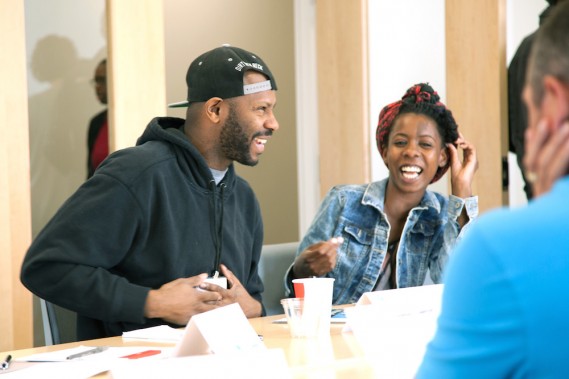Reaching Constituencies: Brainstorming a Targeted Marketing Strategy

Marketing yourself and your artistic work can seem like a daunting task, but it doesn’t have to be. In fact, marketing may be closer to your creative process than you think. The following exercise, developed by Creative Capital President and Executive Director Ruby Lerner, is a step-by-step method for using brainstorming (and other people!) to help define and expand your audience.
For more marketing suggestions, check out Monday’s “Creating a Marketing Strategy” webinar with artist Dread Scott.
This exercise provides an easy way to develop better written and verbal statements around your work. You can choose to take any of these steps on their own or follow the entire process. Hosting a Brainstorming session 6-9 months before your event can help you attract a wealth of new audiences. Brainstorming works best when you have a large group of diverse people. Invite artists, friends, colleagues, etc. Try to aim for a group of 5-10. The goal is to inspire the widest and the most creative range of ideas. Your group can be comprised of people who know your work well or who are strangers to your work. Just make sure that you trust one another, are generous and have fun!
As you move through this process, be sure to adhere to the following guidelines:
- Your gathering should be relaxed and friendly. If people feel free to be silly, they’ll stretch their minds more and produce more creative ideas.
- Pin up a large sheet of paper and use markers to write down information as it is called out, so everyone can refer to it. Have more sheets of blank paper on hand to work on. Identify someone as the scribe.
- Begin by working on questions 1 and 2 (see below), which identify the upcoming event and analyze its content. Most of this information will come from the host artist, but help from the group is encouraged.
When responding to questions, follow the Rules of Brainstorming:
- Everyone can shout out answers to the questions while the scribe records them on the big sheet of paper.
- There must be ABSOLUTELY NO CRITICIZING OF IDEAS. All suggestions are written down, no matter how strange, silly, impossible or obvious. Laughing is to be encouraged. Criticism is not. Why? Because you want to encourage the free flow of ideas. As soon as participants of the Brainstorming session begin to fear criticism of their ideas, they’ll stop generating them. Moreover, ideas that at first seem silly may prove to be very good or may lead to other ideas that are very good.
Questions:
First, identify a project (exhibit, performance, installation, screening, publication) you will be presenting no sooner than 6 months from now.
1. Analyze the project by defining the following:
- Form: What media does your project employ? Where is it presented, or how will it be distributed?
- Content: What is the subject matter of your project?
- Your Approach: What is distinctive about this work? What makes it yours (style, references, interdisciplinary strategies)?
2. Given your analysis of the project in question #1, now answer the following questions:
- Who is this event for?
- Are there individuals or groups outside your traditional audience who might be interested in either the specific content or your particular approach to the material?
After completing question #2 and generating a large list of possibilities, go back through them and select 4 or 5 constituencies that the group likes best. Then continue the brainstorming by answering questions 3 – 7. You may want to use separate sheets of paper for each constituency generated.
3. Given your answers to question #2, now consider the following:
- How do you ACCESS/COMMUNICATE with the individuals or groups you identified above?
- What organizations do they belong to?
- What do they read? Are there publications in which you can advertise, get listings or try to get features?
- Are there other appropriate media outlets, i.e. Radio, TV, Internet that might reach these constituencies?
- Are there journalists or professionals in your field who have supported you in past projects and might help with this one?
- How can you use blogs, email lists, etc. to help facilitate communication about your event?
4. What types of funding might be most appropriate to seek out for this project? (Corporations? Neighborhood businesses? Foundations? Individuals?)
5. What is the best way to approach these funders? Is there an advocate or another artist who could speak to them on your behalf? Can you invite them to current projects, to a reading, to your studio?
6. Can you create an “event” or a collaborative/partnership surrounding this program? Can you combine your project with any other events happening around the same time? What will it take to make a newly created event or a combined event happen?
7. For each constituency you have identified, be able to complete the following sentence: I think you would be interested in ________(the program) because of _______.
The process of Brainstorming in a group is a helpful way to begin developing your target market (or markets) for an event or project. By focusing on expanding your constituencies and connecting with them in relevant and exciting ways, you can cultivate new programming and marketing strategies for your work. Interested in learning more about developing a marketing strategy? Join us for our 4/11 webinar, “Creating a Marketing Strategy”, led by artist Dread Scott.
![]()
